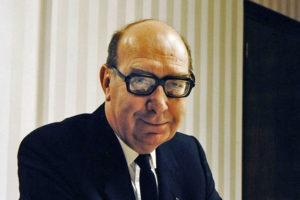In so many ways, the “crisis of masculinity” is a crisis of imagination. We have a vivid, if generalised, image of its victim: the lost boy of modernity surrounded with his clichés of video games, online porn and Jordan Petersons. We take him seriously, cataloguing him nobly as one of society’s most pressing failures — as well as one of its chief villains. But the figure above is little more than a shadowy caricature, and our distance from him is inhibiting our discussion of the problem. A culture that has forgotten to think honestly about what a young man can be like cannot understand what afflicts him, let alone how to fix him.
Which is an odd regression, because we used to know him so well. Long before we delegated mediating this crisis to Caitlin Moran, the wretched young man had his own literary genre: the late-20th century young man’s novel. It was born, loud and cocky, in the Sexual Revolution decades. Spurred on by the general loosening of mores and laws around the depiction of sex on the page, male writers started to compete with each other over who could depict the arrival of sexual maturity in the most appalling, hilarious detail. They would write about themselves at school, themselves in the bedroom and, most perversely, themselves in the bathroom.
As Kingsley Amis later reflected, in the Fifties “to utter or write a swear-word, as they were called, counted as a small act of revolt, the breaking-out of a miniature Jolly Roger”. And at the start of that decade, we had The Catcher in the Rye, a novel which set the thematic tramlines for what was to come (angst, alienation, youngsters vs oldsters). But Holden was a good kid really, his deepest moral sin nothing more than a brief and ultimately chaste parlay with a prostitute. He was overtaken by far meaner younger brothers and, by the end of the Sixties, Philip Roth had produced Portnoy’s Complaint, an unsparing exposé on the dangers of rabid self-abuse. But the greatest and most summative achievement of the lot, arguably retiring the genre in its unstinting imposition of the nastiness, arrogance, misogyny and truth of male adolescence, is Martin Amis’s The Rachel Papers, published 50 years ago.
When Amis died in May, there was much handwringing over exactly what order of talent was being commemorated. A virtuoso stylist, certainly. But a serious novelist? A mere literary comedian? James Wood leant towards the latter, bafflingly labelling Amis our latter-day P.G. Wodehouse. And some dedicated fans simply threw out the fiction in frustration, trusting that the true talent had found its way into the memoir, the essays, the journalism. Quite an insult to the author of 15 novels, and quite misguided, too. Obviously, Amis’s true métier was as one of our great novelists of masculinity — specifically, its most resentful, female-fearing and insecure aspects, exactly those which trouble us about our young men today.
It’s there from the opening lines of The Rachel Papers — “My name is Charles Highway, though you wouldn’t think it to look at me” — that special brew of what, on the next page, Charles calls “all the self-consciousness and self-disgust and self-infatuation and self-…you name it” that is essential to this species of male adolescence. It is the eve of Charles’s 20th birthday, an occasion which is vital for the novel’s plot: a moment of metamorphosis, a simultaneously elevating and enervating release of “teenage” anarchy, to be replaced with “that noisome Brobdingnagian world the child sees as adulthood”. Charles spies an opportunity for self-inspection, even amid the self-absorption. And what follows is his account of the love affair that he believes has marked the last months of his youth, his relationship with Rachel.
What follows is a triumph of stylised solipsism. Charles has kept detailed notes on Rachel (as he does on everything else, from his reading for Oxford entrance to the no less scholarly Conquests and Techniques: A Synthesis). He has analysed seduction like a lepidopterist and places Rachel under a romantic siege-surveillance, pursuing her with all the sleuth and sociopathy of a lusty Sherlock. She is run through a gauntlet of on-the-cuff speeches, calculatedly accidental meetings and pre-prepared gallery visits (Charles goes the day before, to pick out and make notes upon the most aphrodisiac paintings). And this doesn’t let up at the bedroom door. Amis’s sex scenes are pure adolescence: choreographed accounts of first-person pornography, studies of athleticism and repertoire.
“I threw back the top sheet, my head a whirlpool of notes, directives, memos, hints, pointers, random scribblings,” Charles tells us. “Foreplay included ear-jobs, bronchitic sweet-nuthins, armpit-play (surprisingly good value in this respect), and a high-jinks of arse and thigh work.” Charles (and obviously Amis) recognises that this is something new, an attempt to establish a new kind of sexual frankness that will drain any romance from the act. Post-Chatterley, post-Portnoy, no chastity belt may remain locked and no modesty curtain undrawn. Charles, as Amis himself noted, is scholarly about sex and sexual about scholarship. Intimacy is reduced to: “Thus, I maintained a tripartite sexual application in contrapuntal patterns.”
But even more gleefully described is what Charles calls his “adolescentiana”. Asthmatic and scrawny, Charles suffers from a debilitating physical and mental self-consciousness, and regards his body with outright disgust. The Rachel Papers is among other things the great novel of catarrh and phlegm, a tribute to hawking, yacking and barking, of lungs filled with “liquefying gook” and needing to sleep “on a pillow of tissues”. But this doesn’t stop at the bronchials: we hear all about Charles’s “marathon craps”, we see him “peeing lava” after contracting an STI. He shows us his spots in the mirror, cataloguing his “Big Boys” and one “fine double-yolker” frying between his eyes. We even witness him lie “immobile in the bath, like a dirty old alligator — not washing, just steaming and planning”. “Nice things are dull, and nasty things are funny. The nastier a thing is, the funnier it gets,” Charles and Amis declare around halfway through — a literary self-justification. In the quest for comedy, Amis would shamelessly throw all his poetic might at the most shameful, revealing scene.
It is this aggressive frankness that immediately and irrevocably landed the novel with the charge of misogyny. A fair accusation — an older Amis would archly claim that his early novels were written in his “pre-feminist” period. This is Charles on his mother: “What a heap. The skin had shrunken over her skull, to accentuate her jaw and to provide commodious cellarage for the gloomy pools that were her eyes…” On it goes. And it is difficult for the reconstructed reader to know what to do with passages like this, so articulate and so unfunny. Especially since Amis gives Rachel the same attitude towards women over 35: “Scaly faces. Figures go, hair gets matty and dry… it’s good that they can have families.”
Amazing to think that 50 years ago, this was Amis’s ticket to glittering prizes and public acclaim (of a punk-ish, countercultural sort). If this writing is going on now, it’s utterly marginal to publishing, taking place on dubious Substacks, in the far-off terra incognita of the literary manosphere. There is one possible defence here, hanging implicitly and obviously in the air, which is that Charles has to be misogynistic because nasty young men so frequently are, too. And Charles is a monster born of that caste, cranked by his creator into a Hogarthian triumph of high-art cartoonery.
But Charles is vulnerable, too. He’s revolting, and he knows it. And he’s more than capable of devolving into an anxious wreck, crying down the phone when Rachel briefly gets back together with an American love rival, and plagued by “cosmic angst, metaphysical fear, a feeling both claustrophobic and agoraphobic, the teenager’s religion”. The Rachel Papers is too often remembered as a freewheeling carry-on, a snide pamphlet stuffed with lit bro in-jokes. But if Amis grants Charles some of teenagehood’s fleeting highs, he forces him through some of its most punishing lows (one section of vegetative, alcoholic despair is simply referred to as “The Low”).
The disappearance of short-arsed priapics from fiction has not disappeared the aspects of male adolescence they used to satirise. If anything, it has forced them underground, and allowed them to become the blazons of a far darker masculinity. Part of the reason that the manosphere claims its initial sway over young men is by affirming their instinctive (and misogynistic) priors, seizing upon their sensitivities to matters of physical hierarchy and female conquest. These are gendered instincts that our political age is rightly hostile to. But we haven’t examined and disposed of them, only thrown them onto the furnace of the Online Right wherein they are actively stoked and vulcanised.
One of the tragedies of our masculinity crisis conversation is that it is currently brokered only by cold-blooded sociologists (whose books no young man will ever read) and raving internet gurus, whimpering over their wounded pride. One can look over jealously at the sophisticated conversation the girls have on offer — their platter of dislikeable protagonists, dirtbag Fleabags and sad-girl lit. The boys could do with some of their own bad-boy lit. Not delivered with the insouciance of The Rachel Papers — a fresh and chastened perspective is certainly required. But with its daring determination to plumb the grubby lower consciousness of young men, parsing exactly what about it is noxious and what is pitiful (and what is funny) within the uniquely ambiguous field of fiction. And once that is done, perhaps we can trace our way out of this gender animosity, not with a map we have redrawn but one we have reminded ourselves how to read.
Disclaimer
Some of the posts we share are controversial and we do not necessarily agree with them in the whole extend. Sometimes we agree with the content or part of it but we do not agree with the narration or language. Nevertheless we find them somehow interesting, valuable and/or informative or we share them, because we strongly believe in freedom of speech, free press and journalism. We strongly encourage you to have a critical approach to all the content, do your own research and analysis to build your own opinion.
We would be glad to have your feedback.
Source: UnHerd Read the original article here: https://unherd.com/




